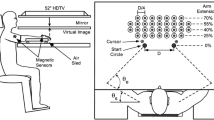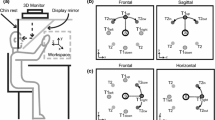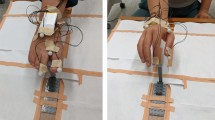Abstract
We have previously proposed a model of motor lateralization that attributes specialization for predictive control of intersegmental coordination to the dominant hemisphere/limb system, and control of limb impedance to the non-dominant system. This hypothesis was developed based on visually targeted discrete reaching movement made predominantly with the shoulder and elbow joints. The purpose of this experiment was to determine whether dominant arm advantages for multi-degree of freedom coordination also occur during continuous distal movements of the wrist that do not involve visual guidance. In other words, are the advantages of the dominant arm restricted to controlling intersegmental coordination during discrete visually targeted reaching movements, or are they more generally related to coordination of multiple degrees of freedom at other joints, regardless of whether the movements are discrete or invoke visual guidance? Eight right-handed participants were instructed to perform alternating wrist ulnar/radial deviation movements at two instructed speeds, slow and fast, with the dominant or the non-dominant arm, and were instructed not to rotate the forearm (pronation/supination) or move the wrist up and down (flexion/extension). This was explained by slowly and passively moving the wrist in each plane during the instructions. Because all the muscles that cross the wrist have moment arms with respect to more than one axis of rotation, intermuscular coordination is required to prevent motion about non-instructed axes of rotation. We included two conditions, a very slow condition, as a control condition, to demonstrate understanding of the task, and an as-fast-as-possible condition to challenge predictive aspect of control, which we hypothesize are specialized to the dominant controller. Our results indicated that during as-fast-as-possible conditions the non-dominant arm incorporated significantly more non-instructed motion, which resulted in greater circumduction at the non-dominant than the dominant wrist. These findings extend the dynamic dominance hypothesis, indicating that the dominant hemisphere-arm system is specialized for predictive control of multiple degrees of freedom, even in movements of the distal arm and made in the absence of visual guidance.









Similar content being viewed by others
References
Amunts K, Schlaug G, Schleicher A, Steinmetz H, Dabringhaus A, Roland PE, Zilles K (1996) Asymmetry in the human motor cortex and handedness. Neuroimage 4:216–222
Annett J, Annett M, Hudson PTW (1979) The control of movement in the preferred and nonpreferred hands. Q J Exp Psychol B 31:641–652
Armour JA, Davison A, McManus IC (2014) Genome-wide association study of handedness excludes simple genetic models. Heredity 112(3):221–225
Bagesteiro LB, Sainburg RL (2002) Handedness: dominant arm advantages in control of limb dynamics. J Neurophysiol 88(5):2408–2421. https://doi.org/10.1152/jn.00901.2001
Barnette JJ, McLean JE (2005) Type I error of four pairwise mean comparison procedures conducted as protected and unprotected tests. J Mod Appl Stat Methods 4(2):446–459
Bryden P (2015) The influence of M. P. Bryden's work on lateralization of motor skill: Is the preferred hand selected for and better at tasks requiring a high degree of skill? Lateral Asymmetries Body Brain Cogn. https://doi.org/10.1080/1357650X.2015.1099661
Bryden M, Singh M, Steenhuis RE, Clarkson KL (1994) A behavioral measure of hand preference as opposed to hand skill. Neuropsychologia 32(8):991–999. https://doi.org/10.1016/0028-3932(94)90048-5
Bryden MP, Roy EA, Mcmanus IC, Bulman-Fleming MB (1997) On the genetics and measurement of human handedness. Laterality 2(3/4):317–336
Bryden PJ, Pryde KM, Roy EA (2000) A performance measure of the degree of hand preference. Brain Cogn 44(3):402–414. https://doi.org/10.1006/brcg.1999.1201
Burdet E, Kawato M, Franklin DW, Osu R, Milner TE (2001) The central nervous system stabilizes unstable dynamics by learning optimal impedance. Nature 414(6862):446–449. https://doi.org/10.1038/35106566
Carson RG, Chua R, Elliott D, Goodman D (1990) The contribution of vision to asymmetries in manual aiming. Neuropsychologia 28:1215–1220
Dassonville P, Zhu XH, Uurbil K, Kim SG, Ashe J (1997) Functional activation in motor cortex reflects the direction and the degree of handedness. Proc Natl Acad Sci USA 94:14015–14018
Dien J (2008) Looking both ways through time: the Janus model of lateralized cognition. Brain Cogn 67:292–323
Ettema GJC, Styles G, Kippers V (1998) The moment arms of 23 muscle segments of the upper limb with varying elbow and forearm positions: implications for motor control. Hum Mov Sci 17(2):201–220. https://doi.org/10.1016/S0167-9457(97)00030-4
Flowers K (1975) Handedness and controlled movement. Br J Psychol (Lond Engl 1953) 66(1):39–52. https://doi.org/10.1111/j.2044-8295.1975.tb01438.x
Gonzalez RV, Buchanan TS, Delp SL (1997) How muscle architecture and moment arms affect wrist flexion-extension moments. J Biomech 30(7):705–712. https://doi.org/10.1016/S0021-9290(97)00015-8
Harris JE, Eng JJ (2006) Individuals with the dominant hand affected following stroke demonstrate less impairment than those with the nondominant hand affected. Neurorehabilit Neural Repair 20(3):380–389. https://doi.org/10.1177/1545968305284528
Hopkins WD (2013) Comparing human and nonhuman primate handedness: challenges and a modest proposal for consensus. Dev Psychobiol 55(6):621–636. https://doi.org/10.1002/dev.21139
Lackner JR, Dizio P (1994) Rapid adaptation to Coriolis force perturbations of arm trajectory. J Neurophysiol 72(1):299–313. https://doi.org/10.1152/jn.1994.72.1.299
Li Z, Kuxhaus L, Fisk JA, Christophel TH (2005) Coupling between wrist flexion–extension and radial–ulnar deviation. Clin Biomech 20(2):177–183. https://doi.org/10.1016/j.clinbiomech.2004.10.002
Liang J, Wilkinson KM, Sainburg RL (2018) Cognitive-perceptual load modulates hand selection in left-handers to a greater extent than in right-handers. Exp Brain Res. https://doi.org/10.1007/s00221-018-5423-z
Liederman J, Healey JM (1986) Independent dimensions of hand preference: reliability of the factor structure and the handedness inventory. Arch Clin Neuropsychol 1(4):371–386. https://doi.org/10.1016/0887-6177(86)90141-1
MacNeilage PF, Rogers LJ, Vallortigara G (2009) Origins of the left and right brain. Sci Am 301:60–67
Mani S et al (2013) Contralesional motor deficits after unilateral stroke reflect hemisphere-specific control mechanisms. Brain 136(4):1288–1303. https://doi.org/10.1093/brain/aws283
Mutha PK et al (2008) Visual Modulation of Proprioceptive Reflexes during Movement. Brain Res 1246:54–69. https://doi.org/10.1016/j.brainres.2008.09.061
Mutha PK, Haaland KY, Sainburg RL (2013) Rethinking motor lateralization: specialized but complementary mechanisms for motor control of each arm. PLoS ONE 8(3):e58582. https://doi.org/10.1371/journal.pone.0058582
Nichols JA, Bednar MS, Havey RM, Murray WM (2015) Wrist salvage procedures alter moment arms of the primary wrist muscles. Clin Biomech 30(5):424–430. https://doi.org/10.1016/j.clinbiomech.2015.03.015
Nichols JA, Bednar MS, Murray WM (2016) Surgical simulations based on limited quantitative data: understanding how musculoskeletal models can be used to predict moment arms and guide experimental design. PLoS ONE 11(6):e0157346. https://doi.org/10.1371/journal.pone.0157346
Pigeon P et al (2003) Coordinated turn-and-reach movements. I. Anticipatory compensation for self-generated coriolis and interaction torques. J Neurophysiol 89(1):276–289. https://doi.org/10.1152/jn.00159.2001
Przybyla A et al (2011) Dynamic dominance varies with handedness: reduced interlimb asymmetries in left-handers. Exp Brain Res 216(3):419–431. https://doi.org/10.1007/s00221-011-2946-y
Przybyla GD, Sainburg R (2013) Virtual reality arm supported training reduces motor impairment in two patients with severe hemiparesis. J Neurol Transl Neurosci 1(2):1018
Przybyla A, Coelho C, Akpinar S, Kirazci S, Sainburg R (2013) Sensorimotor performance asymmetries predict hand selection. Neuroscience 228:349–360. https://doi.org/10.1016/j.neuroscience.2012.10.046
Ramsay JW, Hunter BV, Gonzalez RV (2008) Muscle moment arm and normalized moment contributions as reference data for musculoskeletal elbow and wrist joint models. J Biomech 42(4):463–473. https://doi.org/10.1016/j.jbiomech.2008.11.035
Rogers LJ, Richard JA (eds) (2008) Comparative vertebrate lateralization. Cambridge University Press, Cambridge
Rosenbaum DA (1980) Human movement initiation: specification of arm, direction, and extent. J Exp Psychol Gen 109:444–474
Sainburg RL (2002) Evidence for a dynamic-dominance hypothesis of handedness. Exp Brain Res 142(2):241–258. https://doi.org/10.1007/s00221-001-0913-8
Sainburg RL (2014) Convergent models of handedness and brain lateralization. Front Psychol 5:1092. https://doi.org/10.3389/fpsyg.2014.01092
Sainburg RL, Duff SV (2006) Does motor lateralization have implications for stroke rehabilitation? J Rehabil Res Dev 43(3):311
Sainburg RL, Eckhardt RB (2005) Optimization through lateralization: the evolution of handedness. Behav Brain Sci. https://doi.org/10.1017/s0140525x05440108
Sainburg RL, Kalakanis D (2000) Differences in control of limb dynamics during dominant and nondominant arm reaching. J Neurophysiol 83(5):2661–2675
Sainburg RL et al (1993) Loss of proprioception produces deficits in interjoint coordination. J Neurophysiol 70(5):2136–2147. https://doi.org/10.1152/jn.1993.70.5.2136
Sainburg RL et al (1995) Control of limb dynamics in normal subjects and patients without proprioception. J Neurophysiol 73(2):820–835. https://doi.org/10.1152/jn.1995.73.2.820
Sainburg RL, Schaefer SY, Yadav V (2016) Lateralized motor control processes determine asymmetry of interlimb transfer. Neuroscience 334:26–38. https://doi.org/10.1016/j.neuroscience.2016.07.043
SAS Institute Inc (2016) JMP® 13 fitting linear models. SAS Institute Inc, Cary
Schaefer SY, Haaland KY, Sainburg RL (2007) Ipsilesional motor deficits following stroke reflect hemispheric specializations for movement control. Brain 130:2146–2158
Schaefer SY et al (2009) Hemispheric Specialization and Functional Impact of Ipsilesional Deficits in Movement Coordination and Accuracy. Neuropsychologia 47(13):2953–2966. https://doi.org/10.1016/j.neuropsychologia.2009.06.025
Schaffer JE, Sainburg RL (2017) Interlimb differences in coordination of unsupported reaching movements. Neuroscience 350:54–64. https://doi.org/10.1016/j.neuroscience.2017.03.025
Shmuelof L, Krakauer JW, Mazzoni P (2012) How is a motor skill learned? Change and invariance at the levels of task success and trajectory control. J Neurophysiol 108(2):578–594. https://doi.org/10.1152/jn.00856.2011
Steenhuis RE, Bryden MP (1989) Difference dimensions of hand preference that related to skilled and unskilled activities. Cortex 25:289–304. https://doi.org/10.1016/S0010-9452(89)80044-9
Summa S, Casadio M, Sanguineti V (2016) Effect of position- and velocity-dependent forces on reaching movements at different speeds. Front Hum Neurosci. https://doi.org/10.3389/fnhum.2016.00609
Tomlinson T, Sainburg R (2012) Dynamic dominance persists during unsupported reaching. J Mot Behav 44(1):13–25. https://doi.org/10.1080/00222895.2011.636398
Volkmann J, Schnitzler A, Witte OW, Freund H (1998) Handedness and asymmetry of hand representation in human motor cortex. J Neurophysiol 79(4):2149–2154
Weber KA, Chen Y, Wang X, Kahnt T, Parrish TB (2016) Lateralization of cervical spinal cord activity during an isometric upper extremity motor task with functional magnetic resonance imaging. Neuroimage 125:233–243
Wickelgren WA (1977) Speed-accuracy tradeoff and information processing dynamics. Acta Physiol (Oxf) 41(1):67–85. https://doi.org/10.1016/0001-6918(77)90012-9
Woodworth RS (1899) The accuracy of voluntary movement. Psychol Rev 3:1–114
Woytowicz EJ, Westlake KP, Whitall J, Sainburg RL (2018) Handedness results from complementary hemispheric dominance, not global hemispheric dominance: evidence from mechanically coupled bilateral movements. J Neurophysiol 120(2):729–740. https://doi.org/10.1152/jn.00878.2017
Wyke M (1967) Effect of brain lesions on the rapidity of arm movement. Neurology 17:1113–1120
Yadav V, Sainburg RL (2011) Motor Lateralization is characterized by a serial hybrid control scheme. Neuroscience 196:153–167
Yadav V, Sainburg RL (2014) Handedness can be explained by a serial hybrid control scheme. Neuroscience 278:385–396
Acknowledgements
We would like to acknowledge Dr. David A Wagstaff for his help in the statistical analysis.
Author information
Authors and Affiliations
Corresponding author
Additional information
Communicated by John C. Rothwell.
Publisher's Note
Springer Nature remains neutral with regard to jurisdictional claims in published maps and institutional affiliations.
Rights and permissions
About this article
Cite this article
Srinivasan, G.A., Embar, T. & Sainburg, R. Interlimb differences in coordination of rapid wrist/forearm movements. Exp Brain Res 238, 713–725 (2020). https://doi.org/10.1007/s00221-020-05743-9
Received:
Accepted:
Published:
Issue Date:
DOI: https://doi.org/10.1007/s00221-020-05743-9




